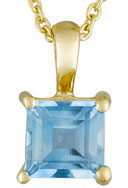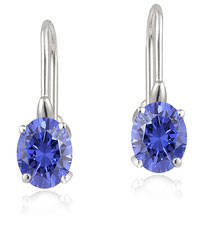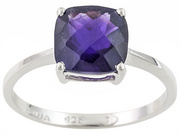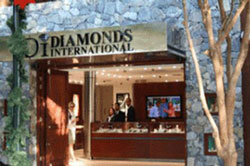Vacation Jewelry – Insurer beware!

Blue Topaz |
That blue topaz pendant or amethyst ring or elaborate gold necklace that your client purchased over the summer vacation is a fine reminder of a wonderful trip.
As a souvenir, it's priceless. But how about its insurance value?
People on holiday expect bargains . . . because labor is cheaper here than at home, because this purchase is duty-free, because the gem is mined here, because the concierge or the cruise director or the friendly tourist they met in the hotel lobby recommended this shop, because a small shop like this has low overhead, because a large emporium like this does such a booming business, it must have quality goods. And these are only the stories the consumer tells herself or himself.
To this open mindset, the scammer's access is easy. A tour bus shows you the city, but the only stops are at tourist sales areas. A cab driver says, I can take you to a government store that's offering a special discount for foreigners and, you're lucky, today is the last day. A shop owner declares that his wife has just given birth to their first son, so he is celebrating by selling diamond and ruby jewelry at 90% off. Tourists all over the world report versions of these very stories, and many others.
And then there are cruises, which one appraiser has called incredible jewelry-selling machines. The captive voyagers are primed with on-board jewelry counters, ads for jewelry shops at ports of call, and "shopping experts" to guide them to the best shops and help them get the best deals. The shops pay a good premium to be on the ship's "recommended" list. Retailers generally mark their prices at ten times cost, knowing that passengers have been told to expect a 70% discount.

Tanzanite |
The big players are available—diamonds, rubies, sapphires—as well as brilliant and colorful eye-catchers, "rare" stones, and gems mined in the region.
Some typical examples:
Tanzanite jewelry is a trendy seller on cruises. There's even a company called Tanzanite International, with outlets in tourist areas around the world. Some cruises give away pairs of tanzanite earrings to draw customers to the jewelry counters.
High quality tanzanite is expensive, but most of what's available is inexpensive because it's pale in color. Also, some jewelry sold as tanzanite turns out to be synthetic forsterite. This happens even in Tanzania, where visitors expect the real thing at reduced prices.

Citrine |
Consumers may not be told—but insurers should be aware—that tanzanite has low resistance to chipping and cracking under impact, so it is a poor choice for a ring or bracelet. The stone may also shatter if exposed to ultrasound cleaning or to a jeweler's torch.
Often a gem is touted as rare, but the product being sold by the retailer is not necessarily rare, or valuable. Naturally occurring blue topaz is rare, but the topaz typically used in jewelry is likely to be gray, pale yellow or pale blue material that's been heat-treated and irradiated to produce a darker, more desirable blue.
Citrine stands out because of its bright color. A transparent, yellow variety of quartz, natural citrine is very rare. However, almost all the material offered under that name is not natural citrine, but heat-treated amethyst. Oddly enough, the pale purple amethyst turns golden when heated.

Amethyst |
Amethyst's natural purple can be very seductive. Up until the 18th century, amethyst was regarded as one of the most valuable gemstones, right up there with diamond, ruby and sapphire. But it lost much of its value since the discovery of extensive deposits. Today JTV can offer 1.79-carat amethyst ring for $29.95. There is also synthetic amethyst, that's even less expensive than the natural. Amethyst is quite brittle and easily chipped.
Some countries do not require gold to be stamped with karatage. If you don't know the karatage of gold, you can't determine its value. And if a piece doesn't bear a karatage mark, it may well be gold plated. Gold chain, often sold aboard cruise ships and in ports as "gold by the inch," may also be merely gold-plated.
 Retailers in tourist areas may supply appraisals or descriptive sales receipts, but these are not necessarily trustworthy. One buyer found, after he'd left the shopping site, that the receipt he was given did not even have the name of the shop on it.
Retailers in tourist areas may supply appraisals or descriptive sales receipts, but these are not necessarily trustworthy. One buyer found, after he'd left the shopping site, that the receipt he was given did not even have the name of the shop on it.
Since a tourist cannot have the jewelry independently appraised to verify its quality, and the retailer is not a dealer of known reputation, the opportunity for fraud is high. Sellers who target tourists know that a disappointed buyer has little recourse once the sale is made and the buyer leaves town (and country).
 You can't count on big names, either. One tourist website enthusiastically proclaims, "If you haven't heard of Diamonds International before, by the time you get on the plane or cruise ship, you will hear a LOT about them!"
You can't count on big names, either. One tourist website enthusiastically proclaims, "If you haven't heard of Diamonds International before, by the time you get on the plane or cruise ship, you will hear a LOT about them!"
This company is one of the largest jewelry retailers in the world, said to have stores in more than 125 locations. Yet Internet blogs show many complaints from customers who, once they got home, had their Diamonds International purchases appraised and found they'd paid two or even three times the jewelry's typical retail value.
Buyers who declare themselves "happy" with their purchases abroad may never have taken that important step of getting the jewelry independently appraised.
Excerpts from a blog – a question and some responses
Has anyone bought jewelry on a cruise ship? I am wondering how reputable they are and if prices are much better.
[I bought ] a sapphire ring.. I could have bought it for half online.
No. I can find better prices at home and if there is a problem, I can easily return to the store.
I bought my wife's engagement ring on a ship, by far not a bargain.
They do push the tanzanite like crazy on cruise ships.
Good luck if there's a problem. I'd rather deal with an established jeweler.
my daughter bought a ring...one of the stones came out the next day...luckily we were still on the ship and she was able to return it. She replaced it with another ring...same thing happened, only this time we were home. ![]()
I'm planning on buying a Citizen watch on my next cruise. They were much cheaper on the ship than I've been able to find them online, by a good amount.
On the ships they're Sitizen watches. [That is, fakes.—JII]
FOR AGENTS & UNDERWRITERS
Be extra vigilant about insuring jewelry purchased out of the country, aboard cruise ships, or under unusual circumstances. "Discounted" prices may, in fact, be excessive; quality may be low; workmanship may be poor; gems may even be imitation.
For jewelry purchased on holiday, it is particularly important to have a detailed appraisal to verify the qualities of the jewelry. Recommend that your client get an appraisal from a trained gemologist (GG, FGA+, or equivalent), preferably one who has additional insurance appraisal training. One course offering such additional training is the Certified Insurance Appraiser™ (CIA) course of the Jewelry Insurance Appraisal Institute.
For colored stones, it is essential that the appraising jeweler be trained and experienced in dealing with colored gems. He must be able to recognize imitations and synthetics; he must know the market for the gem he is examining and be aware of frauds and scams that may be current; and he must be able to describe, in proper gemological language, the color and quality of the gem.
Request a colored gem report from an internationally respected lab such are AGL (American Gemological Laboratories) or Gubelin Gem Lab. You can verify the contents of a report by contacting the labs.
FOR ADJUSTERS
Always have a damaged stone examined in a gem lab to verify its identity and quality before settling the claim.
For all colored gems, be sure to consult an appraiser who regularly deals with colored gemstones, as scams abound. For example, tanzanite is sometimes sold (and may be insured) as sapphire, and synthesized gems may be passed off as natural.
Be suspicious of any damage reported after cleaning or resetting a stone. Some gems, such as tanzanite, are susceptible to fracture from ultrasonic cleaning or the heat of a jeweler's torch. This gem's fragility is an inherent vice (see policy exclusions).
On claims for colored gem jewelry, it is best to rely on a JISO 78/79 appraisal by a jeweler who regularly deals in colored gems. If such an appraisal is unavailable and other documents on file are inadequate, consider consulting a jewelry insurance expert who can help determine the accuracy of the appraisal.
©2000-2025, JCRS Inland Marine Solutions, Inc. All Rights Reserved. www.jcrs.com

